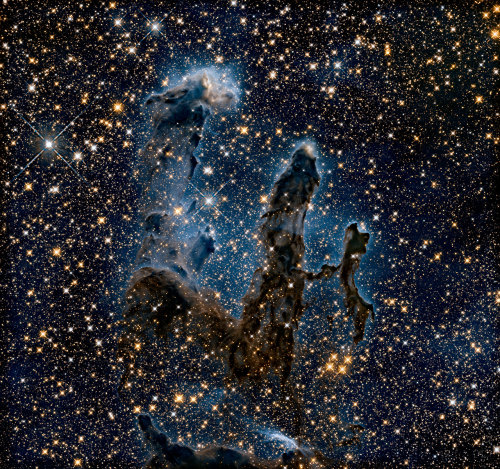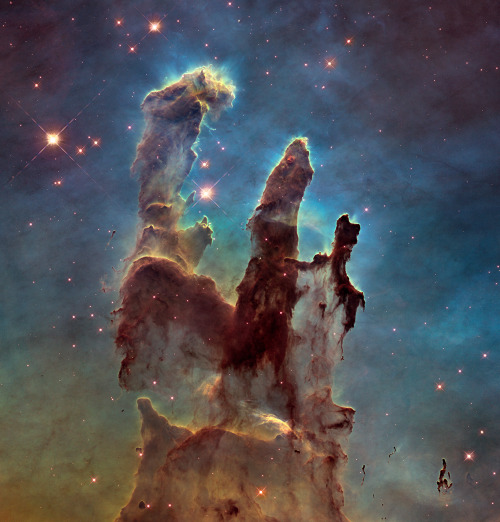'plane-view'

'plane-view'
More Posts from Epic-flight and Others










LUNAR CHRISTMAS – On December 24, 1968, the astronauts of Apollo 8 became the first humans to orbit the Moon. They captured this sequence of amazing images along the way. (NASA)

The Sun, as of December 2, 2016.
The Lives, Times, and Deaths of Stars
Who among us doesn’t covertly read tabloid headlines when we pass them by? But if you’re really looking for a dramatic story, you might want to redirect your attention from Hollywood’s stars to the real thing. From birth to death, these burning spheres of gas experience some of the most extreme conditions our cosmos has to offer.

All stars are born in clouds of dust and gas like the Pillars of Creation in the Eagle Nebula pictured below. In these stellar nurseries, clumps of gas form, pulling in more and more mass as time passes. As they grow, these clumps start to spin and heat up. Once they get heavy and hot enough (like, 27 million degrees Fahrenheit or 15 million degrees Celsius), nuclear fusion starts in their cores. This process occurs when protons, the nuclei of hydrogen atoms, squish together to form helium nuclei. This releases a lot of energy, which heats the star and pushes against the force of its gravity. A star is born.

Credit: NASA, ESA and the Hubble Heritage Team (STScI/AURA)
From then on, stars’ life cycles depend on how much mass they have. Scientists typically divide them into two broad categories: low-mass and high-mass stars. (Technically, there’s an intermediate-mass category, but we’ll stick with these two to keep it straightforward!)
Low-mass stars

A low-mass star has a mass eight times the Sun’s or less and can burn steadily for billions of years. As it reaches the end of its life, its core runs out of hydrogen to convert into helium. Because the energy produced by fusion is the only force fighting gravity’s tendency to pull matter together, the core starts to collapse. But squeezing the core also increases its temperature and pressure, so much so that its helium starts to fuse into carbon, which also releases energy. The core rebounds a little, but the star’s atmosphere expands a lot, eventually turning into a red giant star and destroying any nearby planets. (Don’t worry, though, this is several billion years away for our Sun!)

Red giants become unstable and begin pulsating, periodically inflating and ejecting some of their atmospheres. Eventually, all of the star’s outer layers blow away, creating an expanding cloud of dust and gas misleadingly called a planetary nebula. (There are no planets involved.)

Credit: NASA, ESA, and the Hubble Heritage Team (STScI/AURA)
All that’s left of the star is its core, now called a white dwarf, a roughly Earth-sized stellar cinder that gradually cools over billions of years. If you could scoop up a teaspoon of its material, it would weigh more than a pickup truck. (Scientists recently found a potential planet closely orbiting a white dwarf. It somehow managed to survive the star’s chaotic, destructive history!)

High-mass stars
A high-mass star has a mass eight times the Sun’s or more and may only live for millions of years. (Rigel, a blue supergiant in the constellation Orion, pictured below, is 18 times the Sun’s mass.)

Credit: Rogelio Bernal Andreo
A high-mass star starts out doing the same things as a low-mass star, but it doesn’t stop at fusing helium into carbon. When the core runs out of helium, it shrinks, heats up, and starts converting its carbon into neon, which releases energy. Later, the core fuses the neon it produced into oxygen. Then, as the neon runs out, the core converts oxygen into silicon. Finally, this silicon fuses into iron. These processes produce energy that keeps the core from collapsing, but each new fuel buys it less and less time. By the point silicon fuses into iron, the star runs out of fuel in a matter of days. The next step would be fusing iron into some heavier element, but doing requires energy instead of releasing it.
The star’s iron core collapses until forces between the nuclei push the brakes, and then it rebounds back to its original size. This change creates a shock wave that travels through the star’s outer layers. The result is a huge explosion called a supernova.

What’s left behind depends on the star’s initial mass. Remember, a high-mass star is anything with a mass more than eight times the Sun’s — which is a huge range! A star on the lower end of this spectrum leaves behind a city-size, superdense neutron star. (Some of these weird objects can spin faster than blender blades and have powerful magnetic fields. A teaspoon of their material would weigh as much as a mountain.)

At even higher masses, the star’s core turns into a black hole, one of the most bizarre cosmic objects out there. Black holes have such strong gravity that light can’t escape them. If you tried to get a teaspoon of material to weigh, you wouldn’t get it back once it crossed the event horizon — unless it could travel faster than the speed of light, and we don’t know of anything that can! (We’re a long way from visiting a black hole, but if you ever find yourself near one, there are some important safety considerations you should keep in mind.)

The explosion also leaves behind a cloud of debris called a supernova remnant. These and planetary nebulae from low-mass stars are the sources of many of the elements we find on Earth. Their dust and gas will one day become a part of other stars, starting the whole process over again.
That’s a very brief summary of the lives, times, and deaths of stars. (Remember, there’s that whole intermediate-mass category we glossed over!) To keep up with the most recent stellar news, follow NASA Universe on Twitter and Facebook.
Make sure to follow us on Tumblr for your regular dose of space: http://nasa.tumblr.com.


Don Dixon


Sometimes… there’s more than meets the eye. 👀 You’re looking at two very different takes on an iconic image.
Human eyes can see only a small portion of the range of radiation given off by the objects around us. We call this wide array of radiation the electromagnetic spectrum, and the part we can see visible light.
In the first image, researchers revisited one of Hubble Space Telescope’s most popular sights: the Eagle Nebula’s Pillars of Creation. Here, the pillars are seen in infrared light, which pierces through obscuring dust and gas and unveil a more unfamiliar — but just as amazing — view of the pillars. The entire frame is peppered with bright stars and baby stars are revealed being formed within the pillars themselves. The image on the bottom is the pillars in visible light.
Image Credit: NASA, ESA/Hubble and the Hubble Heritage Team
Make sure to follow us on Tumblr for your regular dose of space: http://nasa.tumblr.com.

Flash Forward.
Twitter / Instagram / Gumroad / Patreon
KnownOrigin / SuperRare / Zedge

Apollo 11 astronaut Neil Armstrong loads rocks into the lunar module, as painted by Apollo 12 moonwalker Alan Bean in 1985.



2014 | Interstellar | Official Concept Art | Source: “Interstellar: Beyond Time and Space” Book by Mark Cotta Vaz
-
 earthkeyper liked this · 2 months ago
earthkeyper liked this · 2 months ago -
 adwbs reblogged this · 4 months ago
adwbs reblogged this · 4 months ago -
 miau476 liked this · 6 months ago
miau476 liked this · 6 months ago -
 forbidden-prism liked this · 8 months ago
forbidden-prism liked this · 8 months ago -
 mariposa-suelta reblogged this · 10 months ago
mariposa-suelta reblogged this · 10 months ago -
 tragedy666 liked this · 1 year ago
tragedy666 liked this · 1 year ago -
 vovantihon liked this · 1 year ago
vovantihon liked this · 1 year ago -
 saygoodnight2theworld liked this · 1 year ago
saygoodnight2theworld liked this · 1 year ago -
 lolalvr liked this · 1 year ago
lolalvr liked this · 1 year ago -
 jookeeerrd liked this · 1 year ago
jookeeerrd liked this · 1 year ago -
 crisantemoj liked this · 1 year ago
crisantemoj liked this · 1 year ago -
 artisticair1067 liked this · 1 year ago
artisticair1067 liked this · 1 year ago -
 epic-flight reblogged this · 1 year ago
epic-flight reblogged this · 1 year ago -
 deadinside8675 liked this · 1 year ago
deadinside8675 liked this · 1 year ago -
 namaenonaihana liked this · 1 year ago
namaenonaihana liked this · 1 year ago -
 luisgot3 liked this · 1 year ago
luisgot3 liked this · 1 year ago -
 nothingamazing liked this · 1 year ago
nothingamazing liked this · 1 year ago -
 transbordei-o liked this · 1 year ago
transbordei-o liked this · 1 year ago -
 niqhttrvde liked this · 1 year ago
niqhttrvde liked this · 1 year ago -
 hvndrixx reblogged this · 1 year ago
hvndrixx reblogged this · 1 year ago -
 hvndrixx liked this · 1 year ago
hvndrixx liked this · 1 year ago -
 marktoservem liked this · 1 year ago
marktoservem liked this · 1 year ago -
 notthisvirgin liked this · 1 year ago
notthisvirgin liked this · 1 year ago -
 nebula52 liked this · 1 year ago
nebula52 liked this · 1 year ago -
 xcalibur124 liked this · 1 year ago
xcalibur124 liked this · 1 year ago -
 judgementcut-end reblogged this · 1 year ago
judgementcut-end reblogged this · 1 year ago -
 lofispacezone liked this · 1 year ago
lofispacezone liked this · 1 year ago -
 spacetravelor reblogged this · 1 year ago
spacetravelor reblogged this · 1 year ago -
 promisingexperience reblogged this · 1 year ago
promisingexperience reblogged this · 1 year ago -
 shamanicnoise liked this · 1 year ago
shamanicnoise liked this · 1 year ago -
 tpl10209777 liked this · 1 year ago
tpl10209777 liked this · 1 year ago -
 tpl10209777 reblogged this · 1 year ago
tpl10209777 reblogged this · 1 year ago -
 xigxagxig reblogged this · 1 year ago
xigxagxig reblogged this · 1 year ago -
 uelden reblogged this · 1 year ago
uelden reblogged this · 1 year ago -
 timeisoutofjoint liked this · 1 year ago
timeisoutofjoint liked this · 1 year ago -
 strawbnie reblogged this · 1 year ago
strawbnie reblogged this · 1 year ago -
 strawbnie liked this · 1 year ago
strawbnie liked this · 1 year ago -
 adwbs reblogged this · 1 year ago
adwbs reblogged this · 1 year ago -
 taken-for-pomegranted reblogged this · 1 year ago
taken-for-pomegranted reblogged this · 1 year ago -
 majesticspacedolphin7 liked this · 1 year ago
majesticspacedolphin7 liked this · 1 year ago -
 iiij0k3riii liked this · 1 year ago
iiij0k3riii liked this · 1 year ago -
 mildevaneios liked this · 1 year ago
mildevaneios liked this · 1 year ago -
 null2023 liked this · 1 year ago
null2023 liked this · 1 year ago -
 agreatdealmanythings liked this · 1 year ago
agreatdealmanythings liked this · 1 year ago

